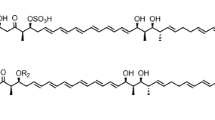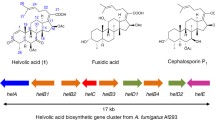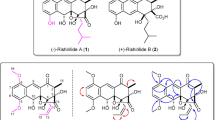Abstract
Genome mining of cyslabdan-producing Streptomyces cyslabdanicus K04-0144 revealed that a set of four genes, cldA, cldB, cldC, and cldD (the cld cluster), which formed a single transcriptional unit, were involved in the biosynthesis of cyslabdan that potentiates imipenem activity against methicillin-resistant Staphylococcus aureus. Experimental studies supported the heterologous expression of the cld cluster of S. cyslabdanicus K04-0144 in S. avermitilis SUKA22, and transformants carrying the cld cluster produced not only cyslabdan A (1), but also its new derivatives, 17-hydroxyl-1 (2) and 2-hydroxyl-1 (3), in the culture broth. An analysis of diterpene metabolites in the mycelia showed that a large amount of a novel intermediate had accumulated and its structure was elucidated as (7S, 8S, 12E)-8,17-epoxy-7-hydroxylabda-12,14-diene (4). The cld-like cluster (rmn cluster) was also detected in the genome of S. anulatus GM95 by searching our in-house genome databases, and the heterologous expression of the rmn cluster in S. avermitilis SUAK22 demonstrated that the rmn cluster was involved in the biosynthesis of the labdane-type bicyclic diterpene, raimonol (7). CldA/RmnA catalyzed the generation of geranylgeranyl diphosphate (GGPP) from dimethylallyl diphosphate and isopentenyl diphosphate. CldB/RmnB converted GGPP to (+)-copalyl diphosphate, and CldD/RmnD generated labda-8(17),12(E),14-triene (5). CldC introduced two oxygen atoms at C-7 and C-8,17 to generate 4, while RmnC hydroxylated 5 at C-7 to generate 7. The heterologous expression of the cld cluster suggested that four gene products catalyzed to generate 4, but not 1. The deletion mutant of the gene encoding the mycothiol (MSH)-S-conjugate amidase (mca) of S. avermitilis SUKA22 carrying the cld cluster failed to produce 1, but accumulated 4 in the mycelia, whereas S. avermitilis SUKA22 and its mca-deletion mutant carrying the cld cluster both produced the MSH-S-conjugate of 4. The intermediate 4 was converted into the MSH-S-conjugate with MSH, which was achieved through a non-enzymatic nucleophilic reaction. The MSH-S-conjugate of 4 generated was further hydrolyzed to generate the mercapturic acid derivative, 1, by MSH-S-conjugate amidase and 1 was excreted from the mycelia.










Similar content being viewed by others
References
Albert H, Dale EC, Lee E, Ow DW (1995) Site-specific integration of DNA into wild-type and mutant lox sites placed in the plant genome. Plant J 7:649–659
Anderberg S, Newton GL, Fahey RC (1998) Mycothiol biosynthesis and metabolism: cellular levels of potential intermediates in the biosynthesis and degradation of mycothiol. J Biol Chem 273:30391–30397
Bohlmann J, Meyer-Gauen G, Croteau R (1998) Plant terpenoid synthases: molecular biology and phylogenetic analysis. Proc Natl Acad Sci USA 95:4126–4133
Bohme CC, Arscott LD, Becker K, Schirmer RH, Williams CH Jr (2000) Kinetic characterization of glutathione reductase from the malarial parasite Plasmodium falciparum. Comparison with the human enzyme. J Biol Chem 275:37317–37323
Camery JR, Hong S-T, Gould SJ (1997) Seongomycin: a new sulfur-containing benzo[b]fluorene derived from genes clustered with those for kanamycin biosynthesis. Tetrahedron Lett 38:3139–3142
Cane DE, He X, Kobayashi S, Omura S, Ikeda H (2006) Geosmin biosynthesis in Streptomyces avermitilis. Molecular cloning, expression, and mechanistic study of the germacradienol/geosmin synthase. J Antibiot 59:471–479
Carman RM, Grant PK (1961) Biformene. J Chem Soc 1961:2187–2191
Dairi T, Hamano Y, Kuzuyama T, Itoh N, Furihata K, Seto H (2001) Eubacterial diterpene cyclase genes essential for production of the isoprenoid antibiotic terpentecin. J Bacteriol 183:6085–6094
Datsenko KA, Wanner BL (2000) One-step inactivation of chromosomal genes in Escherichia coli K-12 using PCR products. Proc Natl Acad Sci USA 97:6640–6645
Franco R, Schoneveld OJ, Pappa A, Panayiotidis MI (2007) The central role of glutathione in the pathophysiology of human diseases. Arch Physiol Biochem 113:234–258
Fukumoto A, Kim Y-P, Matsumoto A, Takahashi Y, Shiomi K, Tomoda H, Omura S (2008) Cyslabdan, a new potentiator of imipenem activity against methicillin-resistant Staphylococcus aureus, produced by Streptomyces sp. K04-0144 I. Taxonomy, fermentation, isolation and structural elucidation. J Antibiot 61:1–6
Fukumoto A, Kim Y-P, Hanaki H, Shiomi K, Tomoda H, Omura S (2008) Cyslabdan, a new potentiator of imipenem activity against methicillin-resistant Staphylococcus aureus, produced by Streptomyces sp. K04-0144 II. Biological activities. J Antibiot 61:7–10
Hooper AM, Rickards RW (1998) 3-Amino-5-hydroxybenzoic acid in antibiotic biosynthesis. XI. Biological origins and semisynthesis of thionaphthomycins, and the structures of naphthomycins I and J. J Antibiot 51:845–851
Ikeda C, Hayashi Y, Itoh N, Seto H, Dairi T (2007) Functional analysis of eubacterial ent-copalyl diphosphate synthase and pimara-9(11),15-diene synthase with unique primary sequences. J Biochem 141:37–45
Ikeda H, Kotaki H, Omura S (1987) Genetic studies of avermectin biosynthesis in Streptomyces avermitilis. J Bacteriol 169:5615–5621
Ikeda H, Nonomita T, Usami M, Ohta T, Omura S (1999) Organization of the biosynthetic gene cluster for the polyketide anthelmintic macrolide avermectin in Streptomyces avermitilis. Proc Natl Acad Sci USA 96:9509–9514
Ikeda H, Ishikawa J, Hanamoto A, Shinose M, Kikuchi H, Shiba T, Sakaki Y, Hattori M, Omura S (2003) Complete genome sequence and comparative analysis of the industrial microorganism Streptomyces avermitilis. Nat Biotechnol 21:526–531
Jothivasan CK, Hamilton CJ (2008) Mycothiol: synthesis. Biosynthesis and biological functions of the major low molecular weight thiol in actinomyccetes. Nat Prod Rep 25:1091–1117
Ketterer B (1982) The role of nonenzymatic reactions of glutathione in xenobiotic metabolism. Drug Metab Rev 13:161–187
Komatsu M, Takano H, Hiratsuka T, Ishigaki Y, Shimada K, Beppu T, Ueda K (2006) Proteins encoded by the conservon of Streptomyces coelicolor A3(2) comprise a membrane-associated heterocomplex that resembles eukaryotic G protein-coupled regulatory system. Mol Microbiol 62:1534–1546
Komatsu M, Tsuda M, Omura S, Oikawa H, Ikeda H (2008) Identification and functional analysis of genes controlling biosynthesis of 2-methylisoborneol. Proc Natl Acad Sci USA 105:7422–7427
Komatsu M, Uchiyama T, Omura S, Cane DE, Ikeda H (2010) Genome-minimized Streptomyces host for the heterologous expression of secondary metabolism. Proc Natl Acad Sci USA 107:2646–2651
Komatsu M, Komatsu K, Koiwai H, Yamada Y, Kozone I, Izumikawa M, Hashimoto J, Takagi M, Omura S, Shin-ya K, Cane DE, Ikeda H (2013) Engineered Streptomyces avermitilis host for heterologous expression of biosynthetic gene cluster for secondary metabolites. ACS Synth Biol 2:384–396
Koyama N, Tokura Y, Takahashi Y, Tomoda H (2011) New cyslabdans B and C, potentiators of imipenem activity against methicillin-resistant Staphylococcus aureus produced by Streptomyces sp. K04-0144. Acta Pharm Sin B 1:236–239
Koyama N, Tokura Y, Münch D, Sahl HG, Schneider T, Shibagaki Y, Ikeda H, Tomoda H (2012) The nonantibiotic small molecule cyslabdan enhances the potency of beta-lactams against MRSA by inhibiting pentaglycine interpeptide bridge synthesis. PLoS ONE 7:e48981
Koyama T (1999) Molecular analysis of prenyl chain elongation enzymes. Biosci Biotechnol Biochem 63:1671–1676
McCaskill D, Croteau R (1997) Prospects for the bioengineering of isoprenoid biosynthesis. Adv Biochem Eng Bio/Technol 55:107–146
Newton GL, Av-Gay Y, Fahey RC (2000) N-Acetyl-1-d-myo-inosityl-2-amino-2-deoxy-α-d-glucopyranoside deacetylase (MshB) is a key enzyme in mycothiol biosynthesis. J Bacteriol 182:6958–6963
Newton GL, Fahey RC (2002) Mycothiol biochemistry. Arch Microbiol 178:388–394
Noma M, Suzuki F, Gamou K, Kawashima N (1982) Two labdane diterpenoids from Nicotiana raimondii. Phytochemistry 21:395–397
Ohtawa M, Hishinuma Y, Takagi E, Yamada T, Ito F, Uchida R, Kim Y-P, Omura S, Tomoda H, Nagamitsu T (2015) Structural revision and protecting group-free synthesis of cyslabdan (in preparation)
Omura S, Fujimoto T, Otoguro K, Matsuzaki K, Moriguchi R, Tanaka H, Sasaki Y (1991) Lactacystin, a novel microbial metabolite, induces neuritogenesis of neuroblastoma cells. J Antibiot 44:113–116
Rawat M, Uppal M, Newton G, Steffek M, Fahey RC, Av-Gay Y (2004) Targeted mutagenesis of the Mycobacterium smegmatis mca gene, encoding a mycothiol-dependent detoxification protein. J Bacteriol 186:6050–6058
Rynkiewicz MJ, Cane DE, Christianson DW (2001) Structure of trichodiene synthase from Fusarium sporotrichioides provides mechanistic inferences on the terpene cyclization cascade. Proc Natl Acad Sci USA 98:13543–13548
Seemann M, Zgai G, Kraker JW, Paschall CM, Christianson DW, Cane DE (2002) Pentalenene synthase. Analysis of active site residues by site-directed mutagenesis. J Am Chem Soc 124:7681–7689
Starks CM, Back K, Chappell J, Noel JP (1997) Structural basis for cyclic terpene biosynthesis by tobacco 5-epi-aristolochene synthase. Science 277:1815–1820
Takano H, Hashimoto K, Yamamoto Y, Beppu T, Ueda K (2001) Pleiotropic effect of a null mutation in the cvn1 conservon of Streptomyces coelicolor A3(2). Gene 477:12–18
Tetzlaff CN, You Z, Cane DE, Takamatsu S, Omura S, Ikeda H (2006) A gene cluster for biosynthesis of the sesqui-terpenoid antibiotic pentalenolactone in Streptomyces avermitilis. Biochemistry 45:6179–6186
Yamada Y, Cane DE, Ikeda H (2012) Diversity and analysis of bacterial terpene synthases. In: Hopwood DA (ed) Chapter seven, Natural product biosynthesis by microorganisms and plants, part A, methods in enzymology, vol 515. Academic Press, New York, pp 123–166
Yamada Y, Kuzuyama T, Komatsu M, Shin-ya K, Omura S, Cane DE, Ikeda H (2015) Terpene synthases are widely distributed in bacteria. Proc Natl Acad Sci USA 112:857–862
Yamada Y, Arima S, Nagamitsu T, Johmoto K, Uekusa H, Eguchi T, Shin-ya K, Cane DE, Ikeda H (2015) Novel terpenes generated by heterologous expression of bacterial terpene synthase genes in an engineered Streptomyces host. J Antibiot 68:385–394
Acknowledgments
We thank Y. Yamada and T. Uchiyama for their technical assistance in this study. This work supported by a research Grant-in-Aid for Scientific Research on Innovative Areas from the Ministry of Education, Culture, Sports, Science and Technology of Japan (to H.I.), and a research Grant-in-Aid for “Project focused on developing key technology of discovering and manufacturing drug for next-generation treatment and diagnosis” from the Ministry of Economy, Trade and Industry of Japan (to K.S. and H.I.).
Author information
Authors and Affiliations
Corresponding author
Additional information
Special Issue: Natural Product Discovery and Development in the Genomic Era. Dedicated to Professor Satoshi Ōmura for his numerous contributions to the field of natural products and congratulated him on the winning of The Nobel Prize in Physiology or Medicine 2015.
Electronic supplementary material
Below is the link to the electronic supplementary material.
Rights and permissions
About this article
Cite this article
Ikeda, H., Shin-ya, K., Nagamitsu, T. et al. Biosynthesis of mercapturic acid derivative of the labdane-type diterpene, cyslabdan that potentiates imipenem activity against methicillin-resistant Staphylococcus aureus: cyslabdan is generated by mycothiol-mediated xenobiotic detoxification. J Ind Microbiol Biotechnol 43, 325–342 (2016). https://doi.org/10.1007/s10295-015-1694-6
Received:
Accepted:
Published:
Issue Date:
DOI: https://doi.org/10.1007/s10295-015-1694-6




